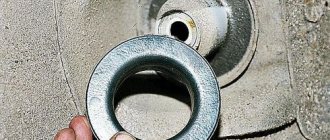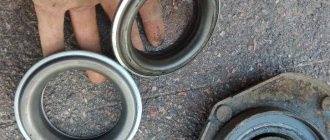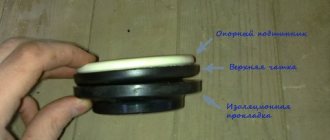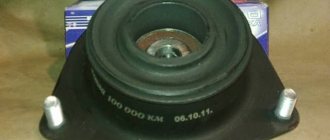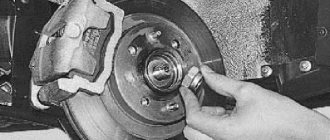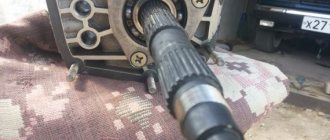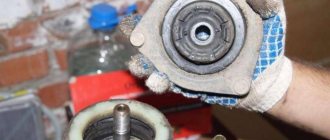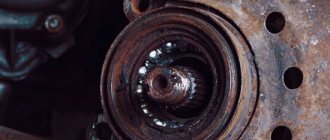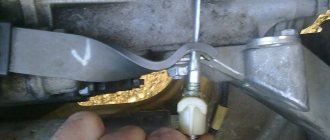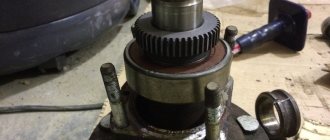Greetings colleagues! I would like to know if there is any clear strategy for replacing the support bearing of a VAZ 2110? Just recently, dull knocks began to be made, one friend said that it was a bearing that had flown. I want to try to replace it myself, although I have never had such experience before. Difficult work or not?
Nothing complicated, buy an ss-20, change it, and ride to your health
Yes: you take a hammer, a new support and change it. It’s best to get a puller. Buy a new support bearing SS-20 or Acomi
The service life of the original support bearing on the VAZ 2110 is 90-95 thousand kilometers. It may fail even earlier if the machine is operated under difficult conditions. I advise you not to delay the replacement, and it’s best not to wait until it starts knocking.
Change the bearings after 60-65 thousand kilometers; on our roads this is the most optimal period. Now I’ll tell you how I personally replace the support bearing on my car.
Replacing the support bearing of a VAZ 2110
Today, the most budget prop for a VAZ 2110 costs about 300 rubles. I prefer to install products from SS-20. I personally have witnessed high-quality bearings that last more than 70 thousand kilometers. A good option is also products from Asomi, they cost about 800 rubles. Set it once and forget it, as they say. In general, there is plenty to choose from.
Now the replacement itself:
- Place the car on a flat surface
- From the side we need, we jack up the car body
- Using a puller, press out the tip pin
- If there is no puller, carefully knock it out with a hammer
- Unscrew the fastenings of the lower part of the strut in the steering knuckle
- Under the hood we find three bolts securing the upper support to the body - unscrew
- Dismantling the shock absorber
- Using zip ties, we clamp the spring and unload the support
- We release the fastenings of the support to the rack, and then remove the assembly
Now we can safely replace the support bearing itself. When you have installed the new part, reassemble the assembly in the reverse order. Next, try the car in action. Drive around the area, listen to whether the extraneous sounds have disappeared or not. But, in most cases, the car suspension does not require any other manipulations after replacing the bearing. That's all.
During operation of the VAZ 2110, heavy loads fall on the support bearing - it provides a movable connection between the car body and the shock absorber. Wear of this unit will manifest itself in the form of creaking noises and other noises. Once symptoms appear, you should immediately think about solving the problem. This article will tell you about ways to eliminate “ten” bearing failures.
Signs of support wear
Replacing the front strut supports of a VAZ 2110 when worn
The main “symptom” of bearing wear is a dull knock on the car body when crossing road irregularities:
- You should try to visually identify the malfunction of the shock-absorbing supports. To carry out an inspection, you need to open the hood. Changes are immediately noticeable if the rubber support is not in its place. If it is deformed or damaged, the supports will have to be replaced.
- If the supports are not replaced in a timely manner, they can affect and reduce the service life of the shock absorbers, leading to damage to the VAZ body. To prevent this from happening, when replacing shock absorbers, you must simultaneously change the supports. Typically, replacing shock absorbers with mounts will cost less. A separate replacement of the supports costs almost the same as replacing the shock absorbers themselves.
Upper supports fail for two reasons
Upper support of the vase stand
The upper supports of shock absorber struts installed on VAZ vehicles are characterized by reliability and durability. You won’t have to change such parts often, but sometimes you can’t do without this procedure. Usually the upper supports are replaced for two reasons:
- The first reason is cracks and tears in the rubber part. This can happen due to aging of the rubber. At first glance, there is nothing serious, but a support in such a condition will be much worse at reducing noise and shock while the vehicle is moving.
- The second reason is more obvious, it is more irritable. This concerns the failure of the upper support bearings. This situation can occur more often than a rubber element breaking, and it adds more worry.
Note! It is worth noting that a support with a damaged bearing knocks quite loudly, even if there are minor irregularities on the roads. This irritates the driver’s nervous system, and probably immediately creates a desire to replace the upper supports.
Support bearings for struts VAZ 2110
Support bearing VAZ 2110: functions and types
The VAZ 2110 has an autonomous front suspension with hydraulic struts designed to dampen the swing that appears during the movement of the springs. Let's look at the functionality of the unit using the following example: a car is driving along the road, and its front wheel falls into a hole of decent size. One of the sides of the car begins to sway. If there were no stand, the swing would take quite a long time.
Fasteners also play an important role. At the top the rack is attached to the body, at the bottom - to the steering knuckle. To ensure the mobility of the connection, an adapter in the form of a support is used. The very name of the component indicates that it is designed for increased loads. It is very important in terms of safety and traffic comfort.
There are several types of carrier bearings. An element with a built-in ring is attached to the body near the mounting holes. There is no need to use special devices for fastening. The design of a bearing with a removable inner ring involves fixing the outer ring to the car body. It is installed if the outer rings must rotate with great precision.
The design with a removable outer ring is the antipode of the described mechanism. The inner ring is firmly attached to the body, the outer ring can be detached. The element is used if high accuracy of rotation of the inner ring is required. The design separates the outer ring at a certain point. This ensures high rigidity.
What does a breakdown lead to?
If the carrier bearing fails, a muffled knocking noise will be heard from the front of the machine. It is especially pronounced when driving on uneven roads. This means that the integrity of the element is compromised. He is no longer able to perform the task correctly. The reasons may be:
- the service life has been exhausted;
- the suspension was under too much load;
- the bearing is dirty inside or moisture has entered it.
Any malfunction of the vehicle's front suspension can cause partial loss of controllability and deformation of the bearing housing. A defect can cause a breakdown of the “glass” to which the shock absorber is connected. The geometry of the body will be disrupted and handling will deteriorate. In addition, the rack can receive serious damage.
When to change
The VAZ 2110 support bearing needs to be replaced after 100,000 km. It is better to change it more often - after 50,000-60,000 km, if the car is operated in Russian conditions. This is especially true for units that were not purchased new.
Replacement of bearings is necessary after identifying faults in the unit during diagnostics. If you do not change it, not only the body will suffer, but also the supports along with the racks. We recommend replacing both load-bearing elements at once.
They are inexpensive. The price of a product from a domestic manufacturer does not exceed 300 rubles. The cost of alternative options reaches 800 rubles. Their design has been slightly modified to suit consumer requirements.
They also sell the entire support assembly. Price - from 1200 to 3000 rubles per set. At the service center, work to replace the support mechanism costs about 500 rubles.
How to check the support bearing of a VAZ 2110
Before replacing an element, make sure it is faulty. The check must be carried out at least once every 20,000 km. At least 2 people must participate. The procedure is:
- We turn off the car and put on the handbrake. We install anti-roll bars under the wheels.
- Raise the hood and remove the casing from the glass.
- Now one person puts his hand on the support, while the other is rocking the car.
- During the procedure, we make sure that the stand does not “play.”
- If during rocking you hear extraneous noise (crunching, knocking), this is a clear sign of a problem - repair is pointless, the bearing must be removed and replaced with a new one.
You can also check the support while the car is moving. You need to carry out simple maneuvers at low speed - turning or braking. If the unit is faulty, there will be a dull noise coming from the front of the machine. When this occurs, the steering wheel begins to move slightly to the right.
To check, you can drive over a speed bump. If the support is out of order, the shock absorber will creak. This method of checking is best used in frosty weather.
Replacement
You made the right decision by replacing the support. An inspection was carried out, and it showed that there was no way without replacement.
To work you will need a certain set of tools:
- Balloon wrench;
- A pair of spring ties;
- Pliers;
- 19, 13 and 9 mm wrenches;
- Jack;
- Puller for steering tips;
- If you don't have a puller, then take a small pry bar and a hammer.
We recommend using a puller, as it ensures simpler and more accurate work.
Dismantling works
Everything is ready, so you can proceed directly to the repair work.
- Choose a level area for the car. A regular garage should be enough.
- Raise the front of the car on the side where you plan to replace the first bearing. For this you will need a jack. Then remove the wheel.
- Using pliers, the fastening nut of the steering tips is uncoiled and then removed using a 19 mm wrench.
- The finger is pressed out using a puller. If you couldn’t find the puller, then carefully tap the finger from below with a hammer, prying it up with a pry bar from below. Make sure that the thread on the finger is not damaged. Otherwise you will have to change it too. This is why a puller is the best solution.
- Again, use a 19 mm wrench to unscrew the nuts on the bottom of the steering knuckle strut. There are two of them. Sometimes they get stuck and become rusty. Use WD40 to loosen it.
- We move to the engine compartment, where you will find three mounting nuts that hold the upper support to the body. They are dismantled with a key number 13.
- Unload the support by tightening the spring with two ties.
- Remove the central mounting nut that holds the support to the post. You will need two keys - 22 and 9.
- Remove the support and disassemble the assembly.
- Remove the bearing and then install a new one in its place.
- Carry out the assembly procedure in reverse order.
- By analogy, replace the support on the side of the second front wheel. The procedure there is no different from the one performed above.
After completing the replacement, drive out onto a flat section of the road and drive a little. Then you need to ride on an uneven surface.
If everything is fine, there are no extraneous noises or knocks, all that remains is to go to a service station, where they will adjust the position of the wheel angle.
A method for replacing a support bearing without unscrewing the camber bolts and without adjusting the wheel alignment.
You will need special tools. — A device for unscrewing the nuts of the struts — Ties for springs. — Steering end puller (I didn’t need it)
1. Remove the hub cap and unlock the CV joint nut. (My nut was so tight that neither a screwdriver nor any pick could be reached, so I decided to use a drill and a suitable drill bit)
2. Use the head to push the CV joint nut through the wrench until it rotates easily. The assistant presses the brake at this time.
3. Raise the car on a jack and remove the wheel.
4. Unscrew the steering tip nut and unscrew it. Using a hammer and a pry bar, press out the finger.
5. Unscrew the 2 ball mounting bolts and disconnect the ball.
6.Release the brake hose from the strut.
7. Unscrew the 2 caliper bolts, first bending the washer petals. and move the caliper to the side (do not leave it hanging on the brake hose).
8. In order to make it easier to work with it “on your knees” after removing the stand, remove the nut from the stand, but do not unscrew it. Next, unscrew the 3 support nuts.
9. Unscrew the CV joint nut. We take out the rack while simultaneously pulling the CV joint from the splines.
10.Tighten the spring and then unscrew the support bearing.
11. Install a new support. We assemble everything in reverse order.
Don't forget that you need to install a new nut. Tighten and lock with a large torque.
What is not clear, ask!
Mileage: 70750 km
How to change the support bearing on a VAZ 2110
Proceed with the procedure by first preparing a new consumable and a set of necessary tools. In addition to the usual wrenches, pliers and other things, you need to find a puller for steering tips - with it the work will be done more accurately. Follow the instructions below.
Place the car on a level surface - maybe in a garage. Using a jack, lift the front of the car where the faulty element is located. Remove the wheel. Then remove the cotter pin from the nut that secures the tie rod ends. Unscrew the nut using a 19mm wrench.
Take a puller and use it to unpress the finger. If you cannot get the puller out, tap your finger with a hammer from below. It is important to ensure that the threads remain intact. Otherwise you will have to change your finger too.
Using the same 19mm wrench, unscrew the nuts at the bottom of the steering cam strut - there are only two of them. Unscrewing them can be difficult, as they can become stuck or become rusty. In this case, it is recommended to use WD40.
Now look under the hood and find the nuts securing the upper support. The nuts are unscrewed using a 13mm wrench. The support is unloaded by tightening the spring with ties. Then unscrew the nut securing the support to the stand. To do this, you will need 2 keys - “9” and “22”.
After this, the support can already be removed and disassembled. We remove the old bearing and put a new one in its place. We assemble the mechanism in the reverse order.
About replacing an assembled part
If there are leaks on the shock absorber, the entire strut needs to be replaced. To do this, you need to carry out the disassembly process:
- Hang up and dismantle the wheel;
- Loosen the top fastenings;
- Remove the brake caliper with hose;
- Disconnect the steering tip and CV joint;
- Disconnect the steering knuckle;
- Dismantle the unit;
- Replace the brake disc, spring and other elements on the new strut, and then reassemble.
It is important to remember that after such a procedure it is necessary to adjust the wheel alignment, because when dismantling the shock absorber, the camber bolts are disconnected.
Functions
As you probably know, the VAZ 2110 model has an independent front suspension and hydraulic struts. The purpose of the struts is to dampen vibrations that occur when the springs move.
Let's look at the situation. You are driving along the road and the wheel falls into a decent hole. One side of the car begins to rock. If there were no rack, your car would rock for a very long time.
Fasteners play an important role. The rack is mounted on top of the body, and on the bottom - to the steering knuckle. To make the connection between the body and the shock absorber movable, an adapter is used - a support bearing. Actually, from the name of this transition element it becomes obvious that the device is designed for maximum axial and radial loads, and is located directly at the junction with the body of your car. It is difficult to overestimate its importance for your comfort and safety.
Why do you need support?
Replacing the upper strut support of a VAZ 2110
The shock absorber support is also called a shock absorber pad or a shock absorber pad. Due to this part, the shock absorber and its rod are attached to the car body.
Note! When a car moves, it is often exposed to the impact force of potholes and potholes in the road. In this case, it is extremely important to reduce these shock loads, which should not reach the car body.
It is these problems that are dealt with by the shock absorber supports and the shock absorbers themselves, which are secured not directly, but through supports. They can be seen when you open the hood of the car. As a rule, they are located on the right and left above the wheels of the car. In frequent cases, the shock absorber support may consist of a rubber gasket that absorbs impacts with vibrations, and a bearing of different shapes. As a rule, everything depends on the design features of the arrangement of parts. In the support, a rolling bearing is necessary to reduce the friction force of the shock absorber rod when turning the machine.
Varieties
At the moment, VAZ 2110 cars are equipped with various types of bearings, which have their own design and functional features. Let's look at them.
Bearing type
Peculiarities
With integrated inner or outer ring
Their peculiarity lies in the presence of special mounting holes provided by the manufacturers. This eliminates the need for additional flanges. Such bearings guarantee rotation of the units when using both the inner and outer rings
With detachable rings
In such bearings, the rings are mounted inside
With detachable externally mounted ring
The peculiarity of the element is that the outer ring can be separated if desired, and the inner ring seems to merge with the car body
There is no significant difference from the bearings under consideration, however, the rigidity of the rings is much higher.
When choosing a bearing, you should focus on quality. This is the most important criterion when purchasing.
What to choose?
Now let's talk about what manufacturers are ready to offer us today.
- Regular ones. Purchasing them will cost you about 300-400 rubles apiece, depending on the region and store. Good design, solid resource.
- Cheap Chinese supports. You will pay about 300 rubles for them, but the quality literally screams not to buy.
- Foreign and domestic analogues. Here we advise you to pay special attention to such products as TRACK, ASOMI, SS20, Fenox. Good quality, more reliable resource compared to standard ones. But you have to pay for quality. Any of the presented bearings today will cost no more than 800 rubles per unit.
- If simply replacing the bearing is not enough, you will have to replace the entire upper support. You will spend about 1500-3000 rubles on this. And only on one support.
- Those who do not want to do the repairs themselves, considering the procedure for replacing the support bearing to be too complicated, can contact a service station. To replace one element you will pay at least 500 rubles.
Which of the presented support bearings is better is a popular question. Choose high-quality analogues, or opt for domestic components. But under no circumstances choose China if you value your car.

